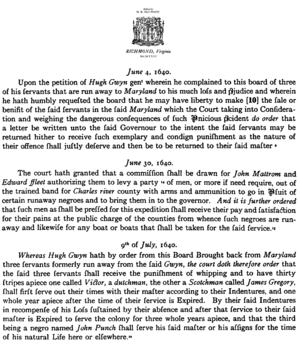John Punch (slave) facts for kids
Quick facts for kids
John Punch
|
|
|---|---|
| Born | fl. 1630s, living 1640 |
| Died | |
| Known for | First official slave in the Thirteen Colonies |
John Punch lived in the colony of Virginia in the 1600s. He was an enslaved African. Many historians believe he was the first person in the English colonies to be officially sentenced to lifelong slavery.
In 1640, John Punch tried to escape to Maryland with two European servants. When they were caught, a court in Virginia gave them different punishments. The European men had to work longer as servants. But John Punch was sentenced to be a slave for the rest of his life. This case was a very important moment in the history of slavery in the United States. It showed a legal difference between Europeans and Africans in the colony.
Contents
Slavery's Start in Virginia
Africans first arrived in Jamestown, Virginia, in 1619. For a long time, historians have debated whether these first Africans were slaves or indentured servants. Indentured servants were people who agreed to work for a set number of years to pay off a debt, usually for their travel to America. After their time was up, they became free.
Some historians think slavery started right away in 1619. Others believe it developed slowly over time, becoming common around the 1660s. However, most experts agree that by 1640, both free Black people and enslaved Black people lived in the Virginia colony.
John Punch's Life Story
John Punch worked for a wealthy landowner named Hugh Gwyn. Gwyn was an important person in Virginia. He was a planter (someone who owned a large farm) and a member of the House of Burgesses, which was like the colony's government.
In 1640, John Punch decided to run away. He escaped with two of Gwyn's European indentured servants. They headed towards Maryland. But they were caught and brought back to Virginia.
On July 9, the Virginia Governor's Council held a court hearing. This council was the highest court in the colony. The court decided that all three men would receive thirty lashes. The two European servants were given extra time to serve their master. They had to work four more years after their original contracts ended. But John Punch received a much harsher sentence. The court ordered him to "serve his said master or his assigns for the time of his natural Life here or elsewhere." This meant he would be a slave for the rest of his life.
Sentenced to Lifelong Slavery
The court's decision on July 9, 1640, was very clear. It stated: "Whereas Hugh Gwyn hath by order from this Board brought back from Maryland three servants formerly run away from the said Gwyn, the court doth therefore order that the said three servants shall receive the punishment of whipping and have thirty stripes apiece. One called Victor, a Dutchman, the other a Scotchman called James Gregory, shall first serve out their times with their master according to their Indentures, and one whole year apiece after the time of their service is expired by their said indentures in recompense of his loss sustained by their absence, and after that service to their said master is expired, to serve the colony for three whole years apiece. And that the third being a negro named John Punch shall serve his said master or his assigns for the time of his natural life here or elsewhere."
Historians point out that John Punch's punishment was very different from the European men's. Even though they all committed the same "crime" of running away, only John Punch was condemned to lifelong slavery. This ruling made him a slave, not just a servant with a limited time to serve.
Some historians believe the court's decision was based on the idea that a Christian could not enslave another Christian. Since Punch was presumed to be non-Christian, unlike his European companions, this might have played a role. Also, the court might have wanted to copy the lifelong slavery of Africans that was happening in other colonies in the Caribbean and South America.
Why John Punch's Case Matters
John Punch's case is very important in American history. It was the first known case in Virginia where a Black person was officially sentenced to lifelong slavery. This decision was written down, making it a legal record.
The National Park Service notes that while some Black people were already held in lifelong service, John Punch was the "first documented slave for life."
Many historians agree that this court decision helped establish slavery as a legal practice. It was one of the first times the law made a clear difference between Black and white indentured servants. This difference in punishment showed that the courts were starting to treat people differently based on their race. This was a key step in the development of racial slavery in the American colonies.
Was John Punch an Indentured Servant?
Some historians have wondered if John Punch was an indentured servant to begin with. If he was, his punishment was much harsher than his white companions. If he wasn't, then his sentence might have been seen as less harsh, as he might have been in a different kind of servitude already.
However, most historians agree that it's most likely John Punch was a servant with a limited term, just like the European men. The court's decision specifically mentioned the indentured contracts of Victor and James Gregory, extending them. For John Punch, it simply said he was a "servant" and then sentenced him to "slavery for life." This suggests he was moved from a temporary work agreement to a permanent one.
This change from temporary servitude to lifelong slavery was a big deal. It showed how the legal system in Virginia was starting to create a system of racial slavery, where African American laborers were forced into lifelong bondage.


